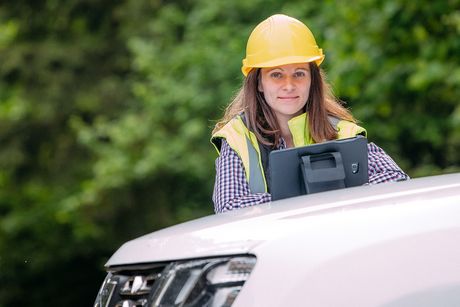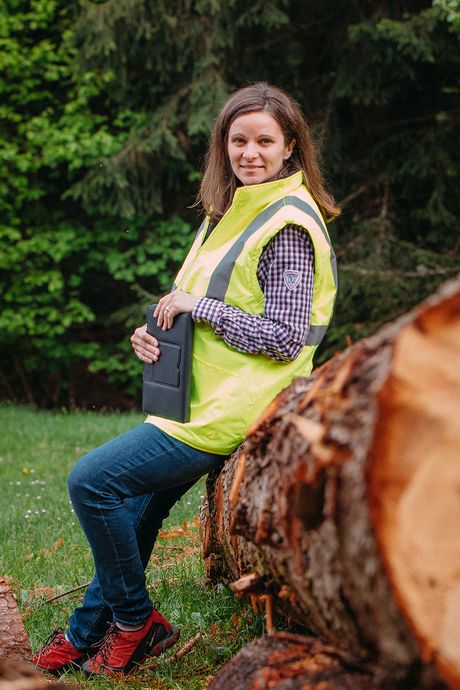“The work of the Compliance and Certification Department is about spreading good practices within the wood industry”: interview with Alexandra Popa, HS Reci
How long have you been with Holzindustrie Schweighofer? What was your professional career?
I started working at Holzindustrie Schweighofer in February 2014, when I was employed in the purchasing department, as head of the Nehoiaşu workstation. Since August 2016 I have been working in the Compliance and Certification Department.
You have studied forestry and are now working for one of the European leaders of the wood processing industry. A profession and industry traditionally perceived as being masculine...
I am a forest engineer, indeed, from the 2013 promotion of the Faculty of Forestry in Brasov. Since college I prepared for this kind of environment, although it was not always easy. For the first two years of college I was the only girl in the group. It’s a challenge, men are allowed to make mistakes, but women aren’t. They are always in the position to prove they can offer something extra in this sector.
At Holzindustrie Schweighofer, however, it was completely different. I am always grateful for the trust that has been given to me: only 23 years old, being a head of workstation, without much experience in the back, it was a very good start and I learned a lot of things. I had a great team, willing to support me at all times. This has helped me to have more confidence in myself and to make my activity easier in this predominantly male environment.
What exactly does your activity consist of?
Shortly, through our work we have to make sure that the wood does not come from controversial sources.
What are the “controversial sources”? Explain, please, for those who do not know very well what we are talking about.
First of all, it is illegally cut wood, obviously. Holzindustrie Schweighofer’s supply policy is much stricter even than the certification schemes and standards. For example, we do not accept wood from National Parks, nor from high conservation forests, virgin forests, I believe all colleagues in the industry know that. Other controversial sources, in the sense of our procurement policy, are considered harvestings that violates civil rights, community rights, or the rights of the workers. Finally, we do not accept wood from the forests where genetically modified species were planted, forests turned into plantations or regions where armed conflicts are taking place. It’s actually a fairly complex audit scheme, but lately, modern technology is helping us a lot.
How do the audit procedures contribute to a sustainable wood industry?
First, our work is not just a simple field verification, we are not inspectors, controlling agents. Of course, having knowledge of a warehouse management, it’s easy for me to check the documentation. But our work in the Compliance Department is also a tool for informing and spreading good practices within the wood industry.
We address a sector that has faced in recent years many legislative changes, regulations that restrict the activity of entire communities, contradictory laws, and minimum tolerances in an area that is the only source of income in some communities. But we want to support our collaborators and partners and we want to inform them about legislative changes, what a due diligence system is, trends in work safety and so on.
To all these, a great amount of help comes from a modern app we use: it is called iAuditor, a fast and useful software. We have a set of questions from which we start various discussions and at the same time we manage to finalize a report and inform collaborators about the problems in certain areas and how to remedy them.
How does modern technology help in the audit process?
It helps through accuracy, speed and professionalism. Imagine an auditor who enters an office with a set of papers. Maybe they are not put in order, she is looking for a pen, then asks questions, asks for evidence (like copies of documents), but the auditee doesn’t have a copy-machine available, so they run fast to the car to get a phone in order to photograph the documents and attach them to the report. The auditor is so busy writing all the information she gets, that she does not have time for other discussions, fails to establish a visual contact with the interlocutor – which is a big mistake, attention and observation are a must, also a certain professional attitude. When she gets to the office and finishes the report, she realizes that some information is missing, so she returns by phone, requests the information, finishes the report and archives it: once in folders and shelved, then scanned, on the server.
Now let's imagine another situation: the auditor enters into the office of the auditee, opens the tablet on the desk, and briefly explains the purpose of this audit and the information needed. Then begins a relaxed conversation, while discreetly ticking the answers she gets. When they get to the document, she asks for permission to take pictures – the photos are uploaded directly into the report. She mentions the confidentiality of the data, notes the non-conformities, and when finalizing, the application warns that some information is missing, so she can return and complete the report. Once it has been finalized, a PDF is exported and sent by email. At all times, due to the ease of use, the auditor maintains visual contact, studies the audience’s reactions and carries a professional conversation.
I think everyone can draw the conclusion now.
Tell us about a situation in the field that surprised you.
Friends often ask me if I met bears, but I saw bears only from the car (and do not think that this would be a funny situation). In my first field audit, I met a man who was a chainsaw operator at the Nehoiaşu workstation. The audit was conducted at a forest unit in another county. It was soothing for me to see a known figure in the middle of the forest, especially since I was at the beginning. It was a lesson at the same time, being a fairly restricted field, at any time you can meet either a friend or an opponent. But I always made it so that I met people only from the first category.
What excites you in your work? Where do you get from the necessary energy?
I think you have the energy when you love what you do. It’s a job that challenges you every day, you always meet new situations, people are different depending on the county in which they operate, because they have different situations. I have learned a lot, not just about certification and compliance, but also about how the world really is. I understand that often the conditions in which we work are not those we imagine and theorize, and then we must react by adapting everything to the context.
What is the greatest satisfaction you have at work?
The greatest satisfaction is when you have results from proposals in which no one initially believed.
Soon you will become a mommy for the second time. How does your company and colleagues help you to be easier during this time?
Yes, it is true. The greatest help was for them to accept that I do not wish to receive any special treatment. Not going to the field would have been more of a hindrance than a help, so I was allowed to do my job as usual and set my own limits. I’m grateful for that.
How do you manage work and family life? What is your secret?
I believe that every family member must also have satisfaction outside of the family life, even the little ones. And as long as you get home happy and full of energy, not overwhelmed by worries and stressed, it’s impossible not to be supported. It's not easy, but in the end it's worth the effort.
Going about the country, what did you find beautiful, interesting and that more deserving of attention from traveling enthusiasts?
There’s a quote that fits me a lot, from Alice in Wonderland:
“Would you tell me, please, which way I ought to go from here?”
“That depends a good deal on where you want to get to,” said the Cat.
“I don’t much care where,” said Alice.
“Then it doesn’t matter which way you go,” said the Cat.
“...So long as I get somewhere,” Alice added as an explanation.
“Oh, you’re sure to do that, said the Cat. If you only walk long enough”. (Alice in Wonderland, chap. VI).
In short, I find it hard to stop in one place. I have many memories of what I saw in site visits, regardless of the season. I’m even glad of the mist and the bruises of the autumn mornings. It does not have to be a special place, you just have to go.
What advice would you give young people who want to pursue a career in the wood industry? In a certification department?
To believe in changes, but be aware that they are being achieved in the long run only through a common effort of all those interested.

